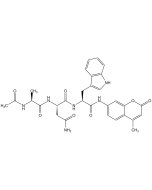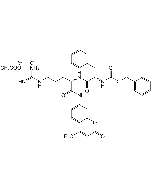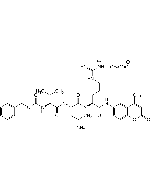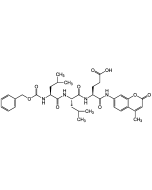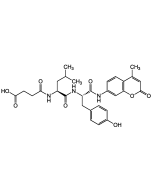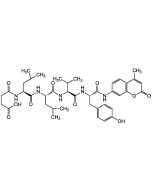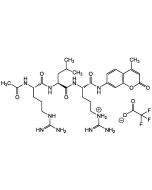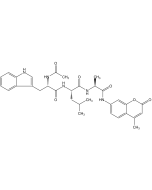Cookie Policy: This site uses cookies to improve your experience. You can find out more about our use of cookies in our Privacy Policy. By continuing to browse this site you agree to our use of cookies.
AdipoGen Life Sciences
Ac-Pro-Ala-Leu-AMC
As low as
65
CHF
CHF 65.00
In stock
Only %1 left
AG-CP3-0036-M0011 mgCHF 65.00
AG-CP3-0036-M0055 mgCHF 140.00
AG-CP3-0036-M02525 mgCHF 560.00
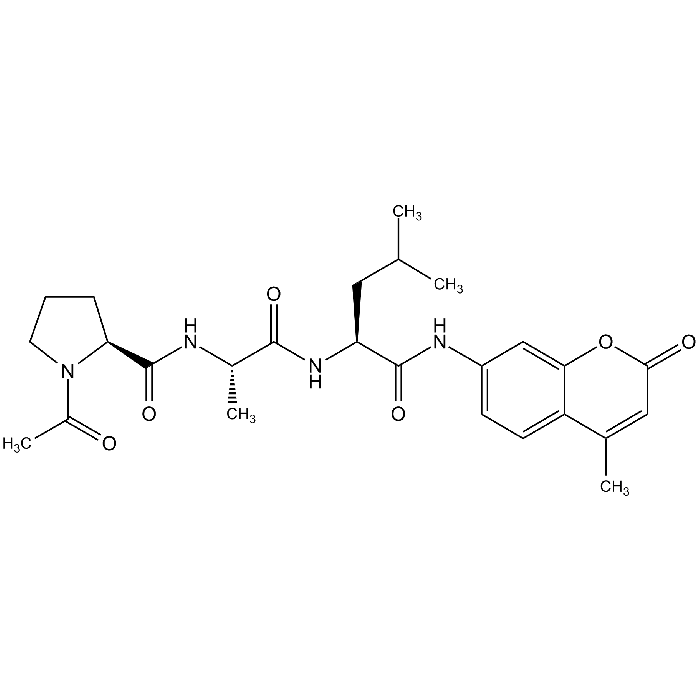
| Product Details | |
|---|---|
| Synonyms | Ac-PAL-AMC; Immunoproteasome Substrate |
| Product Type | Chemical |
| Properties | |
| Formula |
C26H34N4O6 |
| MW | 498.6 |
| Sequence |
Acetyl-Pro-Ala-Leu-7-amido-4-methylcoumarin |
| CAS | 1431362-79-6 |
| Purity Chemicals | ≥97% |
| Appearance | Lyophilized powder. |
| Solubility | Soluble in DMSO. |
| Other Product Data |
Use: After preparing a stock solution in DMSO (≥10mM) store product at -20°C to -80°C. It is recommended to make multiple aliquots after the first thaw to ensure best performance. Caspase-like activity can be measured using a typical working concentration range from 10-50µM. |
| InChi Key | BWJPVHDZSJFFDM-NDXORKPFSA-N |
| Smiles | O=C(C)N1CCC[C@H]1C(N[C@@H](C)C(N[C@@H](CC(C)C)C(NC2 =CC=C(C(C)=CC(O3)=O)C3=C2)=O)=O)=O |
| Shipping and Handling | |
| Shipping | AMBIENT |
| Short Term Storage | +4°C |
| Long Term Storage | -20°C |
| Handling Advice |
Avoid freeze/thaw cycles. Protect from light. |
| Use/Stability | Stable for at least 1 year after receipt when stored at -20°C. |
| Documents | |
| MSDS |
 Download PDF Download PDF |
| Product Specification Sheet | |
| Datasheet |
 Download PDF Download PDF |
Description
- Ac-PAL-AMC is a fluorogenic peptide substrate for measuring caspase-like activity of the immunoproteasome.
- Hydrolysis of this substrate by the β1i/LMP2-subunit of the immunoproteasome is monitored by observing fluorescence at an Excitation wavelength of 345nm and Emission at 445nm.
- This substrate is specific to the immunoproteasome and is not hydrolyzed efficiently by the constitutive proteasome.
Product References
- Characterization of a new series of non-covalent proteasome inhibitors with exquisite potency and selectivity for the 20S β5-subunit: C. Blackburn, et al.; Biochem. J. 430, 461 (2010)
- PSMB9 codon 60 polymorphisms have no impact on the activity of the immunoproteasome catalytic subunit B1i expressed in multiple types of solid cancer: J.E. Park, et al.; PloS one 8, e73732 (2013)
- Inhibitors of the immunoproteasome: current status and future directions: Z. Miller, et al.; Curr. Pharm. Des. 19, 4140 (2013)
- Development and characterization of selective immunoproteasome inhibitors: C. Dubiella; Diss. Universitaet Muenchen (2015)
- Cleavage specificity of Mycobacterium tuberculosis ClpP1P2 protease and identification of novel peptide substrates and boronate inhibitors with anti-bacterial activity: T. Akopian, et al.; J. Biol. Chem. 290, 11008 (2015)
- Discovery of highly selective inhibitors of the immunoproteasome low molecular mass polypeptide 2 (LMP2) subunit: H.W.B. Johnson, et al.; ACS Med. Chem. Lett. 8, 413 (2017)






